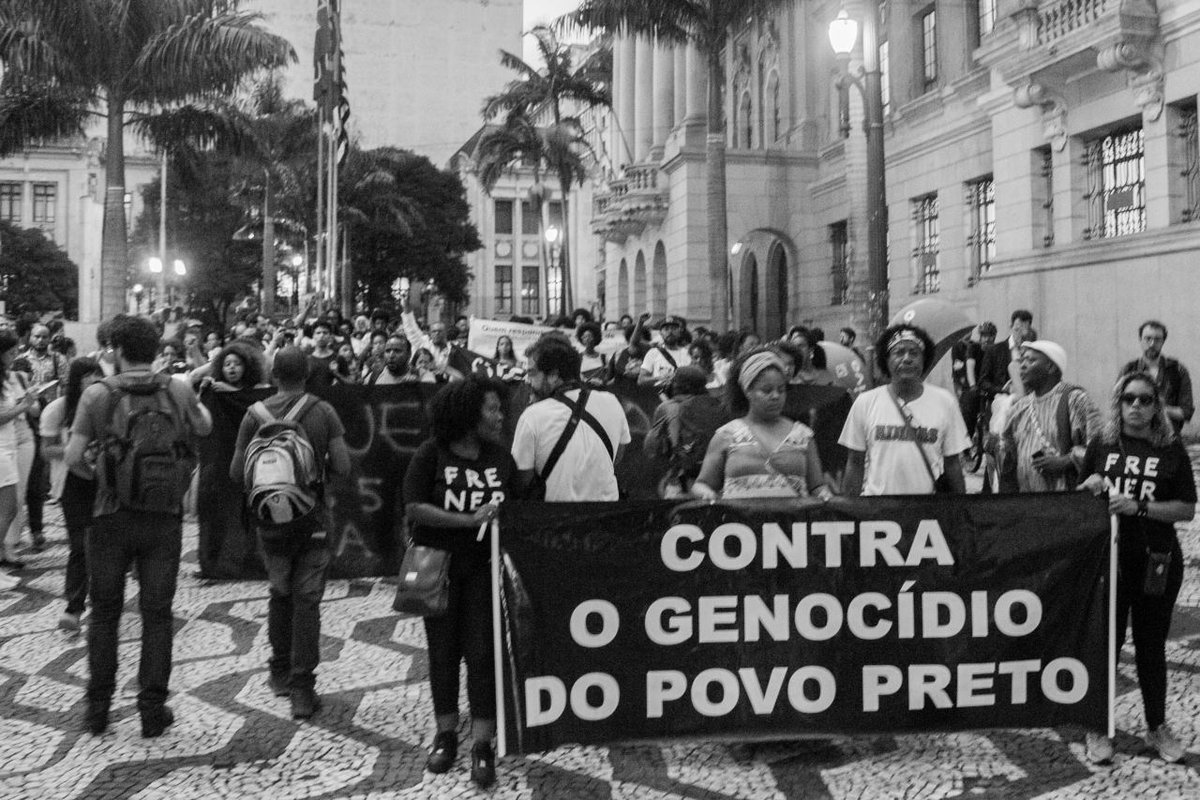New data shows homicides increased during coup year of 2016. Most victims were Afro-Brazilian males.
By Brian Mier
Wednesday, June 6 marked the release of the most comprehensive annual study of national and state level homicide data in Brazil, the 2018 Atlas da Violencia, conducted by 12 researchers from the federal government’s Applied Economic Research Institute (IPEA) and the Brazilian Public Security Forum (FBSP). As a social scientist who spent a decade working on risk reduction projects with vulnerable urban and rural youth for three international NGOs in Brazil, I have been following this annual study since 2002. The following are a few observations based on the new report.
The genocide against Afro-Brazilians is intensifying
Brazil is one of the most violent countries in the world. Afro-Brazilians make up approximately 52% of the Brazilian population but in 2016, the last year for which data is available, they comprised 71% of the homicide victims and were 2.5 times more likely to die as a result of murder than whites. Afro-Brazilian rights movements refer to this, together with the racial disparities in police killings, as a form of genocide. The numbers back up this claim. Over 44,000 Afro-Brazilians were murdered last year in Brazil and, of the 700,000 Brazilians murdered in the last decade, approximately half a million were Afro-Brazilian. To put things in perspective, this is a larger number than the total victims of the War in Iraq.
Crime Statistics do Not Justify the Military Occupation of Rio de Janeiro
Due to the systematic death squad killings of homeless children during the 1990s, films like City of God, the hillside slums located in the middle of tourist neighborhoods and the fact that most foreign correspondents live in Rio de Janeiro, it has an international reputation as one of the World’s most violent cities. When I first moved there in 1991, the murder rate was 60/100,000 and there were over 7000 murders that year. Throughout the 1990s and into the beginning of the 2000s, Rio consistently ranked as one of the most violent states in Brazil. During this period, violence in Brazil was mainly concentrated in the southeastern states like Rio, São Paulo and Espirito Santo and in the lawless areas where the Amazon was being ripped down in states like Pará. As late as 2006, Rio de Janeiro ranked as the 4th most violent state in Brazil. Since then, the north and northeast has been inundated with crack cocaine, organized crime groups from the southeast have come in, and 10 states in the region have seen their homicide rates increase by over 80% in the past decade. In 2016, Rio de Janeiro ranked 13th out of 26 states in terms of homicide, and the top 10 states were all in the north and northeast. Without trying to in any way belittle the pain and suffering of the population of Rio de Janeiro or imply that its murder rate of 36/100,000 is nothing to worry about, the numbers simply do not show a crime crisis when compared to the rest of the nation, at least not something that justifies martial law and a military take over of the state’s security apparatus. The homicide rate in Rio de Janeiro dropped by 23.4% between 2006 and 2016. Rio Grande do Norte, on the other hand, has seen its murder rate rise by 256.9% during the same period. If federal government were really interested in using the military to resolve a crime crisis, you would think it would send them into one of the states where help is most needed, like Rio Grande do Norte. Rio’s military occupation, therefore, is not due to a crime crisis – it’s political.
Social Scientists have not reached a consensus explaining São Paulo’s massive decrease in homicides
Bucking national trends, São Paulo’s homicide rate has plummeted since the turn of the century. In the year 2000, São Paulo state had a murder rate of 34/100,000. By 2016, it had dropped to 10.9 (from 12.2/100,000 in 2015) and the capital, São Paulo city, is now safer than many big North American cities. Furthermore, in a country where Afro-Brazilians are 2.5 times more likely to be victims of murder than whites, São Paulo has the lowest race-based discrepancy among murder victims of any state in the union. The nationwide murder rate for whites is 16/100,000 compared to 40/100,000 for Afro-Brazilians. In São Paulo the numbers are 9/100,000 and 12/100,000 respectively. Like most states in Brazil, São Paulo has cities with favelas, gangs, crack and pockets of extreme poverty. So why has the homicide rate dropped by 2/3 in the last 18 years? The researchers who compiled the Crime Atlas give 5 possible reasons:
1) Policies promoting responsible control of gun ownership; 2) improvements in police efficiency and information systems on criminals; 3) demographic factors such as an accentuated decrease in the proportion of youth in the population; 4) improvements in the labor market; and 5) the Pax Monopolista hypothesis, based on the idea that as the Primeiro Comando da Capital (PCC), gained a near monopoly over organized crime in the state, it reduced its use of lethal violence and this has generated big reductions in homicides in some communities.
As the title of the study implies and despite some attempts at explaining the numbers, the main purpose of the annual Violence Atlas is to map out national and state level trends in violent crime in Brazil. The primary takeaway from this years’ report is that violent crimes rose in 2016. That year was also marked by millions of people dropping below the poverty line, increases in unemployment and huge cuts to the public education system – three factors which can be associated as causal effects on increased violence. Since these three factors have continued and worsened in 2017 and 2018, I believe that, unfortunately, statistics will show that the trend of rising murder rates that disproportionately targets Afro-Brazilian, male youth, will continue in 2017 and 2018.
[qpp]

